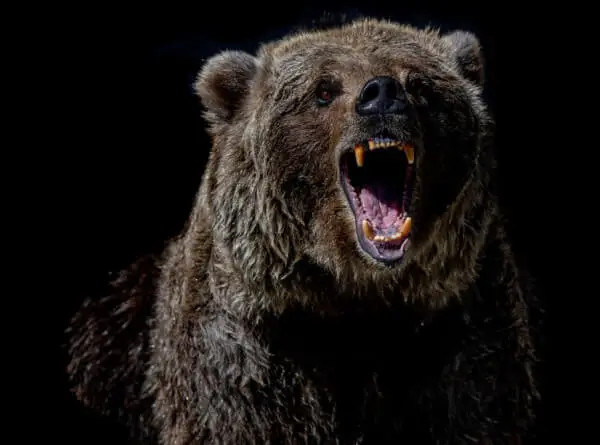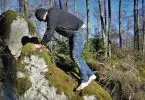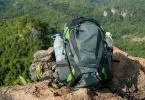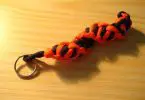Bears are just as afraid of humans as humans are afraid of bears. At least, most of the time. Statistically speaking, people are 45 times more likely to get killed by a dog than a bear. But, on occasion, bears will attack humans.
Bears are omnivores, meaning that they eat both plants and animals. While human flesh usually doesn’t make the list, a bear will attack a human if it is surprised or feels threatened. If you’re recreating in the woods as a backpacker, camper, trail runner, biker or hunter, you must know how to safely share the wilderness with bears.
In this article we’ll talk about the types of bears you may encounter in North America, share tips and tricks to prevent negative encounters with a bear, and finally, how to survive a bear attack.
Where Bear Encounters Are Likely to Happen
To alleviate fear and promote prevention, it’s worth stating that the two most common places for people and bears to encounter each other are:
Where trash is
Dumpsters or garbage cans near the woods or at formalized campgrounds.
Trash is particularly dangerous because if it is not disposed of properly near human spaces, like homes or malls, bears will be drawn closer and closer to humans, lose their fear of us and will learn that this is a space that can be relied on for food.
In the woods
A bear’s natural environment and a recreation space for humans. While you’re hiking, camping, biking, running, and hunting they’re eating, caring for their cubs and moving about.
See also: How to Avoid Wild Animal Attacks: Backpacking Without Unpleasant Events
While it may seem like common sense to some, it is not clear to all that there is a direct link between the woods, trash and human/bear encounters that is highly preventable if we all are a little more aware of how we can shape the woods and our experiences there with our habits.
Remember “a fed bear is a dead bear”. Bears conditioned to humans through food are the most likely to attack and then become hunted and killed by authorities.
Black Bears, And Brown Bears, And Polar Bears… Oh My!
Now that we know where we might run into a bear, let’s figure out which kind of bears we could be dealing with.
There are three types of bears native to North America and they are:
Black Bears
- Habitat: If you encounter a bear in North America, chances are it’s a Black bear. They are present in at least 40 states and both coasts of the United States.
- Personality: Black bears are very skittish and avoid people as much as possible. They typically roam around at night to avoid confrontation for this reason. They’re solitary creatures. If you see more than one bear together, it will likely be a mother and a couple of cubs.
- Physical Characteristics: The name is a bit of a misnomer here. Black bears aren’t always black. While their snouts are often a light brown, their coats can range from black to brown, and from cinnamon to blonde.
They have short snouts and maybe the best distinguishing feature from a Brown bear is that their shoulders don’t form a hump.
They are also the smallest of the three bears we’ll discuss in this article, with males weighing up to around 550lbs as compared to a Brown bear at 600-800lbs and a Polar bear at 700-1500lbs. If you get close enough to see or ideally, find tracks, Black bears have short, non-retractable claws.
Brown Bears (Also known as a Grizzly Bears)
A note on the name: Brown bear is the scientific name given to this kind of bear but only in Alaska and Canada are they commonly called brown bears. The Lower 48 states typically call these bears Grizzlies.
The name “grizzly” comes from Lewis and Clark’s expeditions and applies to the bears in terms of coat color and personality.
- Habitat: Brown bears are mostly found in the Northwestern United States. Places like Utah, Wyoming, Idaho, Montana, Washington, and Alaska. Yellowstone National Park is considered a hub for Brown bears, with about 717 in residence. They can thrive in a few different environments, ranging from dense forests to subalpine meadows, arctic tundra and plains.
- Personality: Unfortunately for humans, Brown bears are more aggressive than Black bears and are less fearful of confrontation. They are inclined to use their size and strength to protect cubs instead of running away.
- They are named “grizzly” in part because of their personality and that they “inspire fear” in all who encounter them. Brown bears are usually solitary animals but are not territorial which means that they may feed together at a decent food source.
- Physical Characteristics: The term “grizzly” also applies to these bear’s coat coloring and size. Grizzlies are often dark brown but like a black bear, coloring can range from blonde to black. The key here, is to look for the long hairs on their backs and shoulders that have white tips, giving them their tell-tale grizzled look. Brown bears also have a distinctive hump in their shoulders when they walk. They have short ears and a concave face.
Polar Bears
- Habitat: These bears are found in Northern Alaska, Canada and Greenland.
- Personality: Polar bears are not accustomed to people and may consider humans prey in an encounter.
- Physical Characteristics: Polar bears and Brown bears are closely related but Polar bears have adapted to live in colder environments. They have white fur, black skin and have a hump on their shoulders similar to Brown bears. Unlike Brown bears, they have webbed feet to enhance swimming. They are the largest species of bear in North America.
Tips For Quick Identification Of Black And Brown Bears
While we can all spot a Polar bear without a problem, Black and Brown bear differentiation can be confusing and they are most common to encounter.
In a life or death situation, knowing the differences between the two can be lifesaving because they require different defensive measures.
Coat Color & Size
Coat color and size are not reliable identifiers because of their variability. The only real color cue would be the grizzled hairs around the shoulders, tipping you off that this bear is a Brown bear. While it’s true that Browns are typically bigger than Blacks, either bear’s size is variable to available food sources.
Below are two tips that are far more reliable for identification:
Look for a hump in the bear’s shoulders
- If there’s a hump, it’s a brown bear.
Look at the claws or track marks
- If the claws are short and thick, it’s Black bear.
- If the claws are long and straight, it’s a Brown Bear.
Types of Attack
Before we can talk about how to protect yourself from a bear attack, it’s important to understand why a bear is attacking. This knowledge will help you to create a plan of defense.
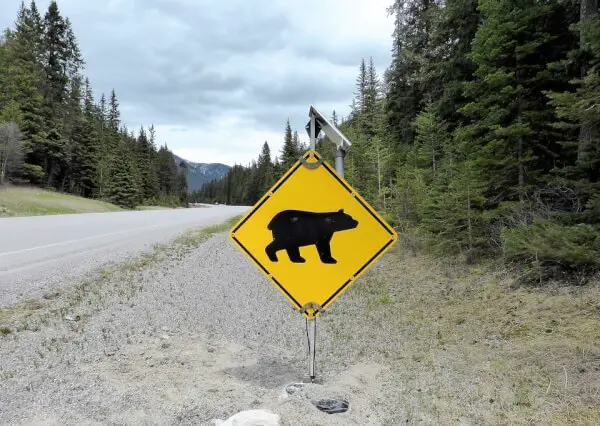
There are two types of bear attacks: Defensive and Predatory.
Defensive Attacks
This type of attack occurs when you take a bear by surprise. In this situation, a bear may try to scare and intimidate you by huffing, clacking its teeth, slapping the ground, and standing on its hind legs. For important guidelines and tips on how to scare a bear, check out our article on this.
Predatory Attacks
Predatory attacks mean one thing for bears: you’re dinner. In this situation, the bear isn’t trying to scare you off or assert itself against a perceived danger, it’s trying to attack you. It will circle you as it determines when and where to strike.
If a bear predatorily attacks you, always fight back.
Bear Safety Tips
If you see a bear at distance but it hasn’t seen you, don’t announce your presence by making a loud noise. This will only scare them and may trigger a violent response. Back away slowly, allowing the bear to move on while you wait from a distance.
If a bear is about 350 feet away, it will sense your presence. Speak in a soft voice and move your arms around, letting the bear know you’re there and mean no harm. If you can, change your direction, but don’t take your eyes off the bear or turn your back until you’re a safe distance apart.
DO NOT RUN & Remain Calm
Your fight or flight response will undoubtedly kick in and it’s important to manage it.
I cannot stress “do not run” enough. This will prompt the bear to transition from a defensive to a predatory attack. They will chase you and they do have the ability to catch you. An average sized bear can run 30mph and they can climb trees.
If you remain calm, the bear will see you as less of a threat and likely lose interest.
Pick up Children and Leash Dogs
Bears may see children and dogs as prey or threats and can attack them if they appear as such. Putting a child on your shoulders will not only keep them safe but will make you look bigger and more intimidating to the bear.
Do Not Make Eye Contact
Bears will consider direct eye contact a challenge.
Make Yourself as Large as Possible
Get to higher ground, lift your arms, trekking poles and anything else you can above your head.
Back Away Slowly and Speak Softly
Check your positioning in relation to the bear’s cubs and their potential escape route. You do not want to get between a sow and her cubs or corner a bear. In either situation, back away slowly and move sideways. This gives the bear(s) room to escape and you will be able to keep an eye on the bear and avoid tripping. As you walk away, do not turn your back, and speak in a soft, low voice.
Do Not Climb A Tree
Black and Brown bears are both skillful tree climbers.
What To Do In A Bear Attack
Black Bear Attack
Fight Back!
Use anything you have- hopefully bear spray is the first and only defensive measure you have to resort to.
If you don’t have bear spray (major mistake if you’re in the woods AT ALL) or it didn’t faze the bear, use rocks, branches, your pack, and anything else you can find. Black bears are more likely to back down if you put up a fight.
Brown Bear Attack
Play Dead
A Brown bear attack will last longer if you fight back. If a Brown bear charges you, lie on your stomach with your pack on. Spread your legs to make it harder for the bear to turn you over and remain as still as possible.
If the attack persists, fight back and aim for the bear’s face.
A Trick to Remember
“If it’s brown, lay down. If it’s black, fight back.”
When It’s Over
When the attack is over, don’t get up as soon as you think the bear is gone, tempting as it may be.
- Continue to lie down and assess your surroundings.
- Listen carefully for sounds indicating that the bear is still nearby.
Once you’re reasonably sure the bear is gone:
- Get up and move in the opposite direction from the one the bear used to exit the scene. You do not want to risk another attack.
- Warn others as you exit the area that there is a dangerous bear.
- Alert authorities and seek medical assistance.
Recreating with Bears
Bear attacks can often be prevented by practicing responsible Leave No Trace ethics.
You now know that smells and improper trash disposal can invite bears into human areas and create a dangerous situation but what are the proper ways to dispose of trash or manage smelly items when camping overnight?
Leave No Trace Ethics (LNT) Include…
Plan Ahead and Prepare
- Contact the area you are visiting for specific wildlife regulations. There may be an increase in bear activity and you’ll want to know about it before getting there or you may find that your park wants you to use only bear canisters instead of bear hangs, for example.
- Bear Proof Food Storage. Once bears have food and humans associated, they will return to places with high human activity and put themselves and us at risk of a dangerous encounter that can lead to death for both parties.
- Remember to place all smelly items in the bear proof containers. Cooking tools, deodorant, lotions, toothpaste, and medications are examples.
- Pack in, Pack out. Don’t leave your trash and garbage scraps. This endangers and inconveniences other campers as well as degrades our relationship with the environment and wildlife.
Campsite Selection
- Select a campsite in an open area. Densely vegetated and forested areas prevent you from being aware of a bear’s presence and vice versa. You are sharing the forest and it’s best to do whatever you can to bring awareness of that to the bear.
- Bear-muda Triangle. To ensure safe camping, LNT suggests that you designate your sleeping, cooking and food storage areas 110 yards from each other.
Respect Wildlife
- Make noise when you’re in the wilderness. Clapping, talking, whistling and singing are all good ways to let the bears know you’re coming through. This is an especially good practice when you’re turning a blind corner, going through thick vegetation, or across noisy streams.
- Hike in groups. Always a practical option, hike with four or more people, especially in Brown bear areas. For some reason, statistically, this makes for safer outdoor adventures.
Notes On Gear
Bear Spray
It’s always a good idea to carry bear spray on your body. Make sure it’s in an easily accessible part of your pack or clipped to your belt. When camping for the night, keep it close in your tent.
Many bear sprays have a glow in the dark safety clip, so you won’t accidentally spray yourself and will be able to find it in the dark. Bear spray isn’t just heavy duty pepper spray. While both are made from the same chemicals, the active ingredients vary and bear spray is meant to shoot farther and over a wider area.
Make sure it says on the label that the spray you’re purchasing is designed to stop bears and that it has the Environmental Protection Agency (EPA) seal.
Warning: Be aware of wind that could blow the spray back at you.
Bear Hangs
Some campsites have bear boxes or bear poles for you to store or hang your bags. When they don’t you’re on your own to make a bear hang. Not to worry, though, it’s a very simple way to keep you and your food safe.
Leave No Trace advises:
- You’ll need your bag, 50ft of rope, and a carabiner. Put all of your smelly items into the bag and close it up. Attach carabiner.
- Choose a tree that is ~200ft away from your cooking and sleeping areas and has a strong branch at least 12ft high off the ground and 6ft from the trunk of the tree and the next nearest branch. Remember: bears can climb!
- Tie a rock to one end of the rope, throw it over the 12ft branch and shimmy it over to the 6ft mark. This may take a few good throws. Be patient and make sure no one is in range of your throw.
- Once you get the rock up and over the branch, take the rock end and pull it towards you. Use this end to hoist the bag into the air.
- Tie the rope to the tree securely enough so that it doesn’t untie overnight.
Bear Canisters
A Bear canister is a portable, hard sided, food locker. While heavier (2-3lbs) and bulkier than a nylon bag you’d use for a bear hang, it is very secure and mandatory in some parks. For reviews of the best bear canisters you can use, do read our article on this topic.
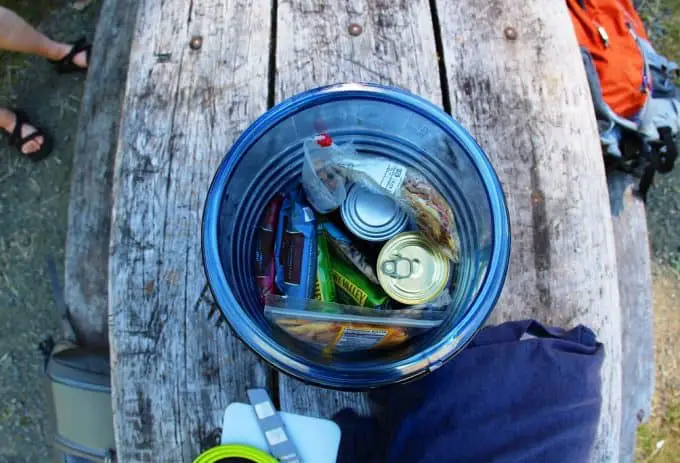
Once can is usually good for 3-5 days’ worth of food and one person’s toiletries.
Tips for Using a Bear Canister:
- Carry it in the center of your pack, close to your back, and near your shoulders.
- Place canisters 100ft from your campsite.
- Don’t store them in a place where they could be knocked off a ledge or into a body of water by curious critters.
Parks that Require the Use of Bear Canisters:
- Denali National Park
- Eastern High Peaks Wilderness Area, Adirondack Mountains
- Gates of the Arctic National Park
- Glacier Bay National Park
- Grand Teton National Park
- Inyo National Forest
- North Cascades National Park
- Olympic National Park
- Sequoia/Kings Canyon National Parks
- Yosemite National Park
Be Bear Aware
The most important way to prevent bear encounters is to be aware of your surroundings and to practice proper Leave No Trace ethics.
But, if you run into a bear in the wild we’ve also broken down the three main types of bears you’ll likely encounter and how to defend yourself if they choose to attack.
Remember, coat coloring and size aren’t always the best way to identify different bears. Brown bears are more aggressive than black bears and have a distinctive hump in their shoulders. The rhyme, if it’s brown lay down, if it’s black fight back is an easy way to remember the basics of surviving an encounter with a bear.
Check out our must-read tips on how to keep bears away from campsite before embarking on your next trip.
Featured Image Source: https://unsplash.com/photos/rGPDLlMNFF4


